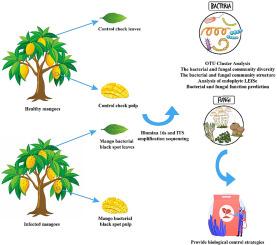The mango bacterial black spot altered the endophyte community structure and diversity
IF 5
1区 农林科学
Q1 FOOD SCIENCE & TECHNOLOGY
International journal of food microbiology
Pub Date : 2024-10-16
DOI:10.1016/j.ijfoodmicro.2024.110941
引用次数: 0
Abstract
Mango bacterial black spot is a major disease limiting mango production, which is now causing increasingly severe economic losses. In this study, we analyzed the differences in the composition and structure of bacterial and fungal communities in the pulp and leaves between the healthy mangoes of variety Kate and those affected by bacterial black spot, and attempted to explore potential biocontrol microorganisms for mangoes. The results showed there existed significant differences in microbial communities, the bacterial Stenotrophomonas, Curtobacterium, Massilia and fungous Penicillium, Alternaria, Aureobasidiu showed great abundance both in pulps and leaves. Some potential pathogenic bacteria, such as Pseudomonas, Xanthomonas, and Burkholderia, were also significantly enriched in the infected groups. In both the infected and healthy groups, the overall community structure of endophytic bacteria and fungi within the same organs was more similar, indicating that the composition of endophytes is organ-specific. After infection, the abundance of the potential probiotic bacterium class Paenibacillus was significantly increased both in leaves and pulp, suggesting that the pathogen invasion stimulated the defense systems of endophytes. Presumably, these Paenibacillus might be developed as defense bacteria for black spot as well as other plant diseases.

芒果细菌性黑斑病改变了内生菌群落结构和多样性。
芒果细菌性黑斑病是限制芒果生产的一种主要病害,目前正在造成越来越严重的经济损失。在本研究中,我们分析了健康芒果(品种为 Kate)与受细菌性黑斑病影响的芒果在果肉和叶片中细菌和真菌群落的组成和结构的差异,并尝试探索芒果潜在的生物防治微生物。结果表明,微生物群落存在显著差异,细菌类的 Stenotrophomonas、Curtobacterium、Massilia 和真菌类的 Penicillium、Alternaria、Aureobasidiu 在果肉和叶片中的含量都很高。一些潜在的病原菌,如假单胞菌、黄单胞菌和伯克霍尔德氏菌,在感染组中也明显富集。在感染组和健康组中,同一器官内的内生细菌和真菌的总体群落结构较为相似,表明内生菌的组成具有器官特异性。感染后,叶片和果肉中潜在的益生菌类Paenibacillus的数量显著增加,表明病原体入侵刺激了内生菌的防御系统。据推测,这些Paenibacillus可能被开发为黑斑病和其他植物病害的防御菌。
本文章由计算机程序翻译,如有差异,请以英文原文为准。
求助全文
约1分钟内获得全文
求助全文
来源期刊
CiteScore
10.40
自引率
5.60%
发文量
322
审稿时长
65 days
期刊介绍:
The International Journal of Food Microbiology publishes papers dealing with all aspects of food microbiology. Articles must present information that is novel, has high impact and interest, and is of high scientific quality. They should provide scientific or technological advancement in the specific field of interest of the journal and enhance its strong international reputation. Preliminary or confirmatory results as well as contributions not strictly related to food microbiology will not be considered for publication.

 求助内容:
求助内容: 应助结果提醒方式:
应助结果提醒方式:


